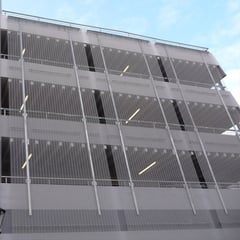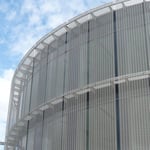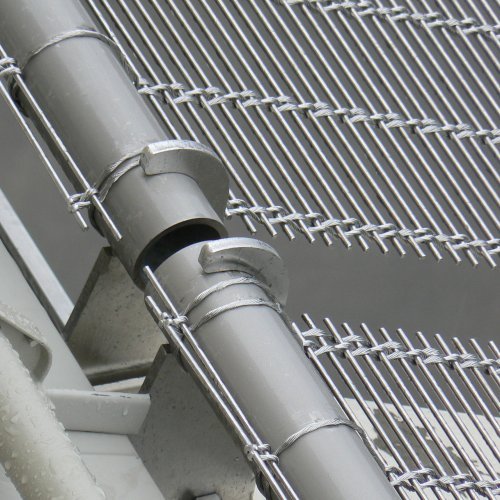Cable Mesh vs Wire Mesh: Picking the Best Architectural Solution
At some point in your life, you have come across architectural mesh and all of its beneficial qualities. From its ability to improve airflow throughout a structure to its sheer looks, the use of architectural mesh provides a well-rounded solution that is unmatched.
With affordable options, like perforated plate panels, and identical solutions, such as cable mesh and architectural wire mesh, it can sometimes be hard to pinpoint the right material to use to build out your façade. That said, what exactly is the difference between cable mesh and wire mesh?
With over 140 years of woven wire mesh experience and 20 plus years of experience working within the world of architecture, W.S.Tyler is here to lead the way.
In this article, we will define both wire mesh as well as cable mesh and provide an in-depth analysis on how the two differ.
What is Architectural Wire Mesh?
Wire mesh is best defined as an assortment of rigid wires that have been woven together to form a sheet of mesh that is interlaced. Wire thickness can range anywhere from 2mm to 6mm on average and all architectural mesh must be woven on a weaving loom specially designed to work with metallic wires.
Why Use Architectural Wire Mesh?
Architectural wire mesh provides architectural designers with a tremendous amount of customization value. With wire mesh, you can change the opening size of the mesh a lot easier, wire diameter in both the weft and warp direction is customizable, and flat wire use is possible.
This level of customization is particularly useful when a project, such as a parking garage, calls for a certain level of air-flow.
What Factors Into The Cost Of Architectural Mesh?

When in comparison to cable mesh, architectural mesh should always be considered first as they both
The overall cost of a wire mesh façade is dependent on several factors. The pattern selection of the wire mesh façade, however, has the biggest effect on its cost. present a similar aesthetic. That said, wire mesh is noticeably cheaper with architectural mesh costing around $20-$25 per square foot and cable mesh costing $30-$35 per square foot.
Typically, the lighter and more open a pattern is, the cheaper the façade will be. Naturally, a heavier pattern requires more material and ultimately costs more.
With that, the overall cost of a wire mesh façade is heavily dictated by the size of the project you are working on.
What is Architectural Cable Mesh?
Cable mesh is, for the most part, similar to wire mesh in the fact that materials are woven on a weaving loom. The major difference is that cable mesh uses cables in vertical, or warp, direction.
Another key difference is that cables in the mesh must be welded at the ends of each wire, unlike wire mesh which is typically cut and left untouched on the edges. This is due to the fact that cables have a tendency to fray and lose their strength after a certain period of time.
The last key difference between cable mesh and traditional wire mesh is seen during the installation process. Instead of using a flat-tension profile at the top and bottom like a wire mesh install, cable mesh utilizes an eyebolt system at the top and bottom.
If you attempted to place a flat-tension profile onto a cable mesh panel, the tension throughout the system would ultimately damage the welding and pull the cables out of the mesh.
Why Use Architectural Cable Mesh?
 Now, when it comes to using cable mesh, the main advantage over traditional wire mesh is its flexibility. To put this into perspective, let’s say you want to incorporate a façade that requires a lot of bends and curves.
Now, when it comes to using cable mesh, the main advantage over traditional wire mesh is its flexibility. To put this into perspective, let’s say you want to incorporate a façade that requires a lot of bends and curves.
To accommodate this aesthetic, you would more than likely be limited to cable mesh, as you risk damaging the rigid wires used in a traditional wire mesh façade.
Another beneficial factor that is offered by cable mesh is the fact that it can be woven with a 13” diameter. This is ideal for applications that want to cover more surface area and want the look of wider panels.
In fact, the biggest drawback associated with wire mesh is the fact that wire mesh panels are limited to a 10-foot width.
Aside from that, some architects simply like the look more, as the cables produce a dazzling shimmer when reflecting the sun’s light. That being said, cable mesh should typically only be used in those specific applications that require the façade to bend and curve drastically.
What Factors Into The Cost Of Cable Mesh?
As stated above, cable mesh carries an average price range of $30-$35 per square foot. But what factors into that cost?
Well, the biggest factor that affects the cost of a cable mesh façade is the welding that is needed to ensure the cables stay intact and in the correct location. Because the welding process is an additional service on top of the weaving of the mesh, cable mesh has a larger price tag than architectural mesh.
That said, this is really the only factor that affects the cost and the other materials and process needed to construct a cable mesh panel is virtually that same as a wire mesh panel.
Get A Better Understanding of Which Material Works Best For You
Architectural wire mesh is best defined as an assortment of rigid wires that have been woven together to form a sheet of mesh that is interlaced. It provides architectural designers with customization values that allow them to apply wire mesh to structures that have strict restrictions like airflow allowance.
On the other hand, cable mesh is a similar solution in that, instead of rigid wires, it utilizes cables in the warp direction. This is especially beneficial for applications that call for extremely flexible material, such as an acoustic façade.
When it comes to pricing, architectural mesh costing around $20-$25 per square foot and cable mesh costing $30-$35 per square foot. Of course, the overall price of your façade will come down to several factors, such as the size of the project and the amount of customization needed.
Having worked with dozens of architectural projects over the span of 20 plus years, W.S. Tyler is here to help no matter which solution you choose.
To learn more about architectural mesh and the benefits that it can bring to your architectural design process, take a look at our Architectural Wire Mesh product guide.
About Ronnie Brown
Ronnie is the Content Writer for W.S. Tyler and has four years of experience as a professional writer. He strives to expand his knowledge on all things particle analysis and woven wire mesh to leverage his exceptional writing and graphic design skills, creating a one-of-a-kind experience for customers.




